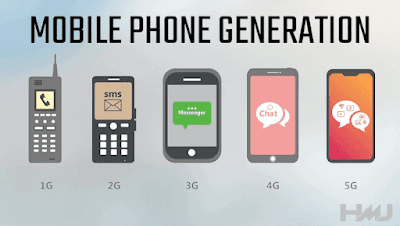Generations of mobile phones (1G....................5G)
 |
Mobile phones have been evolving since their invention in the 1970s. Here are the major generations of mobile phones:
1G: The first generation of mobile phones was launched in the 1980s. It used analog technology for voice communication, which made them bulky and had limited coverage. These phones were primarily used for voice calls and SMS messaging.
2G: The second generation of mobile phones was introduced in the early 1990s. It used digital technology, which allowed for faster data transfer and improved call quality. 2G phones also introduced features such as SMS messaging, call waiting, and caller ID.
3G: The third generation of mobile phones was launched in the early 2000s. It brought significant improvements to data transfer speeds, allowing for multimedia messaging, mobile internet access, and video calling. 3G networks also enabled GPS navigation and mobile TV services.
4G: The fourth generation of mobile phones was introduced in the late 2000s. It brought faster internet speeds and allowed for advanced services such as high-definition video streaming, online gaming, and mobile payments. 4G technology also enabled the use of virtual assistants and augmented reality applications.
5G: The fifth generation of mobile phones was introduced in the late 2010s. It is the most advanced mobile technology to date, providing faster internet speeds, lower latency, and increased network capacity. 5G networks enable advanced services such as self-driving cars, remote surgeries, and smart cities.
Each generation of mobile phones has brought significant improvements in technology and features, leading to the rise of smartphones that can perform a wide range of functions. As mobile technology continues to evolve, we can expect to see even more advanced features and applications in the future.



No comments:
Post a Comment